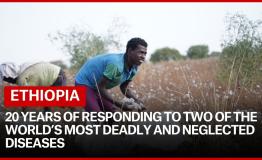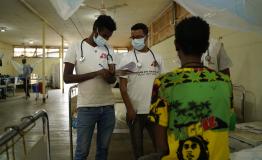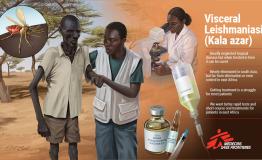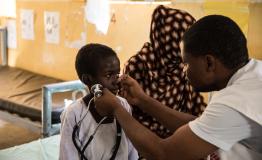

Kala Azar (leishmaniasis)
Kala azar is the second-largest parasitic killer in the world.
Along with Chagas disease and sleeping sickness, kala azar is one of the most dangerous neglected tropical diseases (NTDs). Only malaria is more deadly.
Also known as visceral leishmaniasis, kala azar is the most serious form of leishmaniasis and endemic in 76 countries, with hundreds of millions at risk of infection.
The parasite is spread to humans by bites from infected female sandflies. It attacks the immune system and is almost always fatal if not treated.
There are between 50,000 and 90,000 new cases a year, about 90 per cent of which occur in Brazil, Ethiopia, India, Kenya, Somalia, South Sudan and Sudan, where the disease is endemic.
About Kala Azar
Kala azar is caused by bites from female phlebotomine sandflies – the vector (or transmitter) of the leishmania parasite.
The sandflies feed on animals and humans for blood, which they need for developing their eggs.
If blood containing leishmania parasites is drawn from an animal or human, the next person to receive a bite will then become infected and develop leishmaniasis.
Months after this initial infection, the disease can progress into a more severe form, called visceral leishmaniasis or, kala azar.
Kala azar presents after two to eight months, with more generalised symptoms, including prolonged fever and weakness.
Co-infection of kala azar and HIV is a major challenge, as the diseases influence each other in a vicious spiral as they attack and weaken the immune system.
The most effective diagnostic tests for leishmaniasis are invasive and potentially dangerous, where tissue samples are required from the spleen, lymph nodes or bone marrow.
These tests require lab facilities and specialists not readily available in resource-poor, endemic areas.
The most common method of diagnosing kala azar is by dipstick testing. However, this method is highly problematic. In endemic areas, people can become infected with kala azar, but it may not develop into the disease.
Therefore, no treatment will be required.
Unfortunately, dipstick testing only establishes whether a patient is immune to kala azar – so if the parasite is present, it would appear that the patient has the disease. Because of this, dipstick testing can’t be used to see if the patient is cured, is re-infected or has relapsed.
Today, liposomal amphotericin B is becoming the primary treatment drug in Asia, either alone or as part of a combination therapy.
While safer and shorter than previously used medication, it requires intravenous administration, which remains an obstacle to its use in local clinics. An oral drug, miltefosine, is often added to optimise treatment regimens in patients.
In Africa, the best available treatment is still a combination of pentavalent antimonials and paromomycin, which is toxic and requires a number of painful injections. Research into other treatment combinations is underway.
MSF treated 9,900 patients for kala azar in 2018.


Ethiopia: 20 years of responding to two of the world’s most deadly and neglected diseases

“We don’t know where it comes from but it kills a lot of people”

MSF calls for increased global investment ahead of World Neglected Tropical Disease (NTD) Day on 30 January 2023

Women in the lead: “Together we are stronger”
